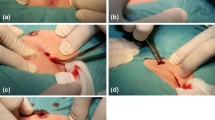Abstract
Purpose
The authors aimed at comparing multiple operative methods for pilonidal disease (PD) and to determine the optimal treatment modality.
Methods
The authors assessed paediatric patients treated with PD between January 2008 and January 2021. Out of 276 patients, 255 met with the inclusion criteria. The total number of treatments were 340 for these 255 patients. Of these 340, the five modalities of therapy were incision only (INC n = 90), direct closure with drainage (DCW n = 172) and without drainage (DWO n = 19), paediatric endoscopic pilonidal sinus treatment (PEPSIT n = 37), and open wound treatment (OWT n = 22). Patients were categorized by age, sex, length of hospital stay (LOS), wound healing time, wound complications, use of antibiotics, and need for repeated hospitalization.
Results
Wound healing was the fastest after INC and the slowest in OWT. Females were treated less invasively than males. Use of antibiotics was the highest in DWO. Wound complications were lowest in INC and OWT; and the same in all other treatment modalities. Repeated hospitalization rate was the highest after INC. Length of stay (LOS) was lowest in PEPSIT and in INC, and by far the highest in OWT. Drainage time was the shortest after INC.
Conclusion
Multiple techniques are known for the treatment of PD. Neither technique proved to be significantly better. However, the authors recommend the use of PEPSIT because of its minimal invasiveness, shortest LOS, and consequent minimal patient discomfort.





Similar content being viewed by others
References
Arda IS, Güney LH, Sevmiş S, Hiçsönmez A (2005) High body mass index as a possible risk factor for pilonidal sinus disease in adolescents. World J Surg 29:469–471. https://doi.org/10.1007/s00268-004-7533-y
Yildiz T, Elmas B, Yucak A, Turgut HT, Ilce Z (2017) Risk factors for pilonidal sinus disease in teenagers. Indian J Pediatr 84:134–138. https://doi.org/10.1007/s12098-016-2180-5
Esposito C, Turrà F, Cerulo M, Del Conte F, Esposito G, Prato AP, Escolino M (2020) Technical standardization of MIS management of children with pilonidal sinus disease using paediatric endoscopic pilonidal sinus treatment (PEPSiT) and laser epilation. J Pediatr Surg 55:761–766. https://doi.org/10.1016/j.jpedsurg.2019.04.031
Bendewald FP, Cima RR (2007) Pilonidal disease. Clin Colon Rectal Surg 20:86–95. https://doi.org/10.1055/s-2007-977486
Zagory JA, Golden J, Holoyda K, Demeter N, Nguyen NX (2016) Excision and primary closure may be the better option in the surgical management of pilonidal disease in the paediatric population. Am Surg 82:964–967
Karydakis GE (1992) Easy and successful treatment of pilonidal sinus after explanation of its causative process. Aust N Z J Surg 62:385–389. https://doi.org/10.1111/j.1445-2197.1992.tb07208.x
Morden P, Drongowski RA, Geiger JD, Hirschl RB, Teitelbaum DH (2005) Comparison of Karydakis versus midline excision for treatment of pilonidal sinus disease. Pediatr Surg Int 21:793–796. https://doi.org/10.1007/s00383-005-1543-1
McCallum IJ, King PM, Bruce J (2008) Healing by primary closure versus open healing after surgery for pilonidal sinus: systematic review and meta-analysis. BMJ 336:868–871. https://doi.org/10.1136/bmj.39517.808160.BE
Buie LA (1937) Practical proctology. W. Saunders
Lord PH, Millar DM (1965) Pilonidal sinus: a simple treatment. Br J Surg 52:298–300. https://doi.org/10.1002/bjs.1800520413
Sequeira JB, Coelho A, Marinho AS, Bonet B, Carvalho F, Moreira-Pinto J (2018) Endoscopic pilonidal sinus treatment versus total excision with primary closure for sacrococcygeal pilonidal sinus disease in the paediatric population. J Pediatr Surg 53:2003–2007. https://doi.org/10.1016/j.jpedsurg.2018.02.094
Fadgyas B, Garai GI, Ringwald Z (2020) Paediatric endoscopic pilonidal sinus treatment: it is time to forget the open procedure?. J Ped Endosc Surg 2:213–215. https://doi.org/10.1007/s42804-020-00076-4
Conroy FJ, Kandamany N, Mahaffey PJ (2008) Laser depilation and hygiene: preventing recurrent pilonidal sinus disease. J Plast Reconstr Aesthet Surg 61:1069–1072. https://doi.org/10.1016/j.bjps.2007.06.022
Søndenaa K, Andersen E, Nesvik I, Søreide JA (1995) Patient characteristics and symptoms in chronic pilonidal sinus disease. Int J Colorectal Dis 10:39–42. https://doi.org/10.1007/BF00337585
Nasr A, Ein SH (2011) A paediatric surgeon’s 35-year experience with pilonidal disease in a Canadian children’s hospital. Can J Surg 54:39–42. https://doi.org/10.1503/cjs.028509
Al-Khamis A, McCallum I, King PM, Bruce J (2010) Healing by primary versus secondary intention after surgical treatment for pilonidal sinus. Cochrane Database Syst Rev 2010(1):CD006213. https://doi.org/10.1002/14651858.CD006213.pub3
Lukish JR, Kindelan T, Marmon LM, Pennington M, Norwood C (2009) Laser epilation is a safe and effective therapy for teenagers with pilonidal disease. J Pediatr Surg 44:282–285. https://doi.org/10.1016/j.jpedsurg.2008.10.057
Landa N, Aller O, Landa-Gundin N, Torrontegui J, Azpiazu JL (2005) Successful treatment of recurrent pilonidal sinus with laser epilation. Dermatol Surg 31:726–728. https://doi.org/10.1111/j.1524-4725.2005.31601
Esposito C, Mendoza-Sagaon M, Del Conte F, Cerulo M, Coppola V, Esposito G, Cortese G, Crocetto F, Montaruli E, Escolino M (2020) Paediatric endoscopic pilonidal sinus treatment (PEPSiT) in children with pilonidal sinus disease: tips and tricks and new structurated protocol. Front Pediatr 8:345. https://doi.org/10.3389/fped.2020.00345
Gips M, Melki Y, Salem L, Weil R, Sulkes J (2008) Minimal surgery for pilonidal disease using trephines: description of a new technique and long-term outcomes in 1,358 patients. Dis Colon Rectum 51:1656–1662. https://doi.org/10.1007/s10350-008-9329-x
Funding
All authors certify that they have no affiliations with or involvement in any organization or entity with any financial interest or non-financial interest in the subject matter or materials discussed in this manuscript.
Author information
Authors and Affiliations
Corresponding author
Ethics declarations
Conflict of interest
None.
Ethical approval
Obtained.
Rights and permissions
About this article
Cite this article
Langer, M., Vajda, P., Tiborcz, K.A. et al. Comparison of five different treatment techniques for pilonidal disease in adolescents: a 13-year experience. J Ped Endosc Surg 4, 55–61 (2022). https://doi.org/10.1007/s42804-021-00124-7
Received:
Revised:
Accepted:
Published:
Issue Date:
DOI: https://doi.org/10.1007/s42804-021-00124-7




